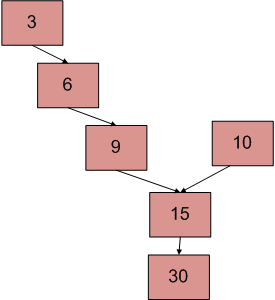用于查找两个链表的交点的Java程序
一个系统中有两个单链表。由于一些编程错误,其中一个链表的结束节点链接到了第二个链表,形成了一个倒 Y 形链表。编写一个程序来获取两个链表合并的点。

上图显示了一个示例,其中两个链表具有 15 个作为交点。
方法1(只需使用两个循环):
使用 2 个嵌套的 for 循环。外部循环将针对第一个列表的每个节点,内部循环将针对第二个列表。在内部循环中,检查第二个链表的任何节点是否与第一个链表的当前节点相同。此方法的时间复杂度为 O(M * N),其中 m 和 n 是两个列表中的节点数。
方法2(标记访问节点):
该解决方案需要修改基本的链表数据结构。每个节点都有一个已访问标志。遍历第一个链表并不断标记访问过的节点。现在遍历第二个链表,如果再次看到访问过的节点,则有一个交点,返回相交的节点。此解决方案在O(m+n)中有效,但需要每个节点的附加信息。不需要修改基本数据结构的该解决方案的变体可以使用散列来实现。遍历第一个链表并将访问节点的地址存储在哈希中。现在遍历第二个链表,如果您看到哈希中已经存在的地址,则返回相交节点。
方法3(使用节点数的差异):
- 获取第一个列表中的节点数,设 count 为 c1。
- 获取第二个列表中的节点数,设 count 为 c2。
- 获得计数的差异d = abs(c1 – c2)
- 现在遍历从第一个节点到 d 个节点的更大列表,以便从这里开始两个列表的节点数相等
- 然后我们可以并行遍历这两个列表,直到遇到一个公共节点。 (注意,获取普通节点是通过比较节点的地址来完成的)
下图是上述方法的试运行:

以下是上述方法的实现:
Java
// Java program to get intersection point
// of two linked list
class LinkedList
{
static Node head1, head2;
static class Node
{
int data;
Node next;
Node(int d)
{
data = d;
next = null;
}
}
/* Function to get the intersection
point of two linked lists head1
and head2 */
int getNode()
{
int c1 = getCount(head1);
int c2 = getCount(head2);
int d;
if (c1 > c2)
{
d = c1 - c2;
return _getIntesectionNode(d, head1,
head2);
}
else
{
d = c2 - c1;
return _getIntesectionNode(d, head2,
head1);
}
}
/* Function to get the intersection point
of two linked lists head1 and head2
where head1 has d more nodes than head2 */
int _getIntesectionNode(int d, Node node1,
Node node2)
{
int i;
Node current1 = node1;
Node current2 = node2;
for (i = 0; i < d; i++)
{
if (current1 == null)
{
return -1;
}
current1 = current1.next;
}
while (current1 != null &&
current2 != null)
{
if (current1.data == current2.data)
{
return current1.data;
}
current1 = current2;
current2 = current2.next;
}
return -1;
}
/* Takes head pointer of the linked list
and returns the count of nodes in the list */
int getCount(Node node)
{
Node current = node;
int count = 0;
while (current != null)
{
count++;
current = current.next;
}
return count;
}
// Driver code
public static void main(String[] args)
{
LinkedList list = new LinkedList();
// Creating first linked list
list.head1 = new Node(3);
list.head1.next = new Node(6);
list.head1.next.next = new Node(9);
list.head1.next.next.next = new Node(15);
list.head1.next.next.next.next = new Node(30);
// Creating second linked list
list.head2 = new Node(10);
list.head2.next = new Node(15);
list.head2.next.next = new Node(30);
System.out.println("The node of intersection is " +
list.getNode());
}
}
// This code is contributed by Mayank JaiswalJava
// Java program to get intersection point
// of two linked list
import java.util.*;
class Node
{
int data;
Node next;
Node(int d)
{
data = d;
next = null;
}
}
class LinkedListIntersect
{
public static void main(String[] args)
{
// list 1
Node n1 = new Node(1);
n1.next = new Node(2);
n1.next.next = new Node(3);
n1.next.next.next = new Node(4);
n1.next.next.next.next = new Node(5);
n1.next.next.next.next.next = new Node(6);
n1.next.next.next.next.next.next = new Node(7);
// list 2
Node n2 = new Node(10);
n2.next = new Node(9);
n2.next.next = new Node(8);
n2.next.next.next = n1.next.next.next;
Print(n1);
Print(n2);
System.out.println(MegeNode(n1, n2).data);
}
// Function to print the list
public static void Print(Node n)
{
Node cur = n;
while (cur != null)
{
System.out.print(cur.data + " ");
cur = cur.next;
}
System.out.println();
}
// Function to find the intersection
// of two node
public static Node MegeNode(Node n1, Node n2)
{
// define hashset
HashSet hs = new HashSet();
while (n1 != null)
{
hs.add(n1);
n1 = n1.next;
}
while (n2 != null)
{
if (hs.contains(n2))
{
return n2;
}
n2 = n2.next;
}
return null;
}
} 输出:
The node of intersection is 15时间复杂度: O(m+n)
辅助空间: O(1)
方法4(在第一个列表中画圈):
感谢Saravanan Man提供以下解决方案。
1.遍历第一个链表(计数元素),制作一个循环链表。 (记住最后一个节点,以便我们以后可以打破圆圈)。
2. 现在将问题视为在第二个链表中找到循环。所以问题就解决了。
3. 由于我们已经知道循环的长度(第一个链表的大小),我们可以遍历第二个链表中的许多节点,然后从第二个链表的开头开始另一个指针。我们必须遍历直到它们相等,这就是所需的交点。
4. 从链表中删除圆圈。
时间复杂度: O(m+n)
辅助空间: O(1)
方法5(反转第一个列表并制作方程式):
感谢Saravanan Mani提供这种方法。
1) Let X be the length of the first linked list until the intersection point.
Let Y be the length of the second linked list until the intersection point.
Let Z be the length of the linked list from the intersection point to End of
the linked list including the intersection node.
We Have
X + Z = C1;
Y + Z = C2;
2) Reverse first linked list.
3) Traverse Second linked list. Let C3 be the length of second list - 1.
Now we have
X + Y = C3
We have 3 linear equations. By solving them, we get
X = (C1 + C3 – C2)/2;
Y = (C2 + C3 – C1)/2;
Z = (C1 + C2 – C3)/2;
WE GOT THE INTERSECTION POINT.
4) Reverse the first linked list.优点:没有指针比较。
缺点:修改链表(倒排表)。
时间复杂度: O(m+n)
辅助空间: O(1)
方法6(遍历两个列表并比较最后一个节点的地址):该方法仅用于检测是否存在交叉点。 (感谢 NeoTheSaviour 的建议)
1) Traverse list 1, store the last node address
2) Traverse list 2, store the last node address.
3) If nodes stored in 1 and 2 are same then they are intersecting.该方法的时间复杂度为O(m+n),使用的辅助空间为O(1)
方法 7(使用散列):
基本上,我们需要找到两个链表的公共节点。所以我们散列第一个列表的所有节点,然后检查第二个列表。
1)创建一个空的哈希集。
2) 遍历第一个链表,将所有节点的地址插入哈希集中。
3) 遍历第二个列表。对于每个节点,检查它是否存在于哈希集中。如果我们在哈希集中找到一个节点,则返回该节点。
Java
// Java program to get intersection point
// of two linked list
import java.util.*;
class Node
{
int data;
Node next;
Node(int d)
{
data = d;
next = null;
}
}
class LinkedListIntersect
{
public static void main(String[] args)
{
// list 1
Node n1 = new Node(1);
n1.next = new Node(2);
n1.next.next = new Node(3);
n1.next.next.next = new Node(4);
n1.next.next.next.next = new Node(5);
n1.next.next.next.next.next = new Node(6);
n1.next.next.next.next.next.next = new Node(7);
// list 2
Node n2 = new Node(10);
n2.next = new Node(9);
n2.next.next = new Node(8);
n2.next.next.next = n1.next.next.next;
Print(n1);
Print(n2);
System.out.println(MegeNode(n1, n2).data);
}
// Function to print the list
public static void Print(Node n)
{
Node cur = n;
while (cur != null)
{
System.out.print(cur.data + " ");
cur = cur.next;
}
System.out.println();
}
// Function to find the intersection
// of two node
public static Node MegeNode(Node n1, Node n2)
{
// define hashset
HashSet hs = new HashSet();
while (n1 != null)
{
hs.add(n1);
n1 = n1.next;
}
while (n2 != null)
{
if (hs.contains(n2))
{
return n2;
}
n2 = n2.next;
}
return null;
}
}
输出:
1 2 3 4 5 6 7
10 9 8 4 5 6 7
4这种方法需要 O(n) 额外的空间,如果一个列表很大,效率不是很高。
有关详细信息,请参阅关于编写函数以获取两个链表的交点的完整文章!